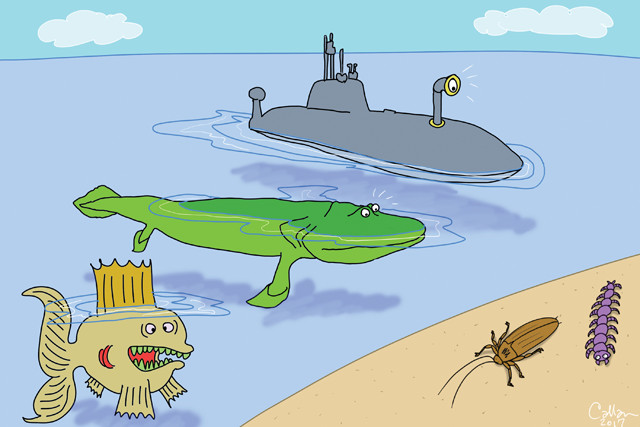
by Mary Caperton Morton Monday, June 19, 2017

Evolutionary advances in aquatic eyesight may have led vertebrates onto land. Credit: ©Callan Bentley, 2017.
In the Middle Devonian, roughly 385 million years ago, the first vertebrates began making their way out of water. For these pioneering fish, the adaptation of fins into limbs facilitated the transition. But in a new study, researchers have found that millions of years before fully functional terrestrial limbs evolved, some fish were developing better eyesight — an evolutionary adaptation they suggest gave an advantage to fish hunting insects near the shore.
Several theories have been proposed about how and why the first vertebrates emerged from the water to live on land, nearly all focusing on the development of limbs as the major turning point. “One early theory suggested that the climate was changing and becoming drier, and that early tetrapods evolved limbs to move from one body of water to the next,” says Lars Schmitz, a paleontologist in the W.M. Keck Science Department of Claremont McKenna, Pitzer and Scripps Colleges in California and a co-author of the new study, published in Proceedings of the National Academy of Sciences.
But other scientists, including the study’s lead author, neuroscientist Malcolm MacIver of Northwestern University, have long suspected that improved eyesight may have also played an important role in the transition to land. “In the water, fish can only see about as far as their body length, giving them very little time to react to both predators and prey,” MacIver says. But above water, even typical fish eyes can see much farther. “Simply bringing the eyes above water, keeping the eyes the same size, increases the range of vision 70 times,” he says. “It’s a remarkable advantage.”
To study how improved vision may have lured fish out of the water eyes-first, MacIver, Schmitz and their colleagues studied 59 taxa of extinct fish and tetrapods that spanned the timing of the vertebrate transition to land. The team looked for evidence of increasing eye size over time, measuring across the eye sockets to estimate eye size. From these measures, they found that the average orbit size in the animals nearly tripled from 13 to 36 millimeters over a 12-million-year period. During that time, the eyes of several taxa also migrated from the side of the head to the top of the head, allowing these animals see above the water while remaining submerged and hunting by stealth, similar to crocodiles.
The team then combined the paleontological data with computer simulations of visual acuity in and out of the water, finding that the enlarged eyes would have increased the visual volume — the visual field the animals could monitor — a millionfold. In a third prong of the multidisciplinary study, the team used previously published phylogenetic trees to document the timing of the visual changes seen in the fossils, placing the adaptations’ development well before the evolution of functional limbs. “When we ran the analysis, we found that the transition to larger eyes occurred much earlier than we expected, in Tiktaalik and other fish that were still fully aquatic,” Schmitz says. Tiktaalik roseae is a so-called “fishapod” species discovered in 2006 that has traits of both fish and tetrapods.
The fish may have been peering out of the water looking for insects or other arthropods, which emerged on land about 50 million years before the first vertebrates, MacIver says. Flying insects didn’t evolve until much later, but crawling varieties — as well as early arachnids, millipedes and centipedes — could have been tempting terrestrial meals. As fish developed better vision and eyes on the tops of their heads, they may have started hunting these critters on the shoreline, sometimes lunging onto land in pursuit of prey. Eventually, some fish developed limbs and began venturing onto land for longer forays until they became primarily terrestrial by 355 million years ago.
The trend toward larger eyes in some taxa of Devonian fish is something that paleontologists interested in the sea-to-land transition of tetrapods had noticed previously, but had not yet fully explored, says Jennifer Clack, a paleontologist at the University of Cambridge in England who was not part of the new study. “This study impresses me. They really did their homework on the paleontology side of things,” she says. The idea that eye development came before limb development “fits nicely into the tetrapod backstory.”
Better vision may also have had other implications for hunting behavior and brain development, but these are difficult to quantify using the fossil record, MacIver says. Because fish can only see up close, they can only react to predators and prey reflexively on millisecond timescales. “As you extend your sensory range, you go from only being able to react to stimuli reflexively to being able to plan your reaction, to learn and to strategize,” he says. Such changes may be reflected in the size and structure of tetrapod brains, so MacIver says the team next plans to study endocasts of tetrapod skulls, looking for evidence of neural development as these animals adapted to life on land.
© 2008-2021. All rights reserved. Any copying, redistribution or retransmission of any of the contents of this service without the expressed written permission of the American Geosciences Institute is expressly prohibited. Click here for all copyright requests.